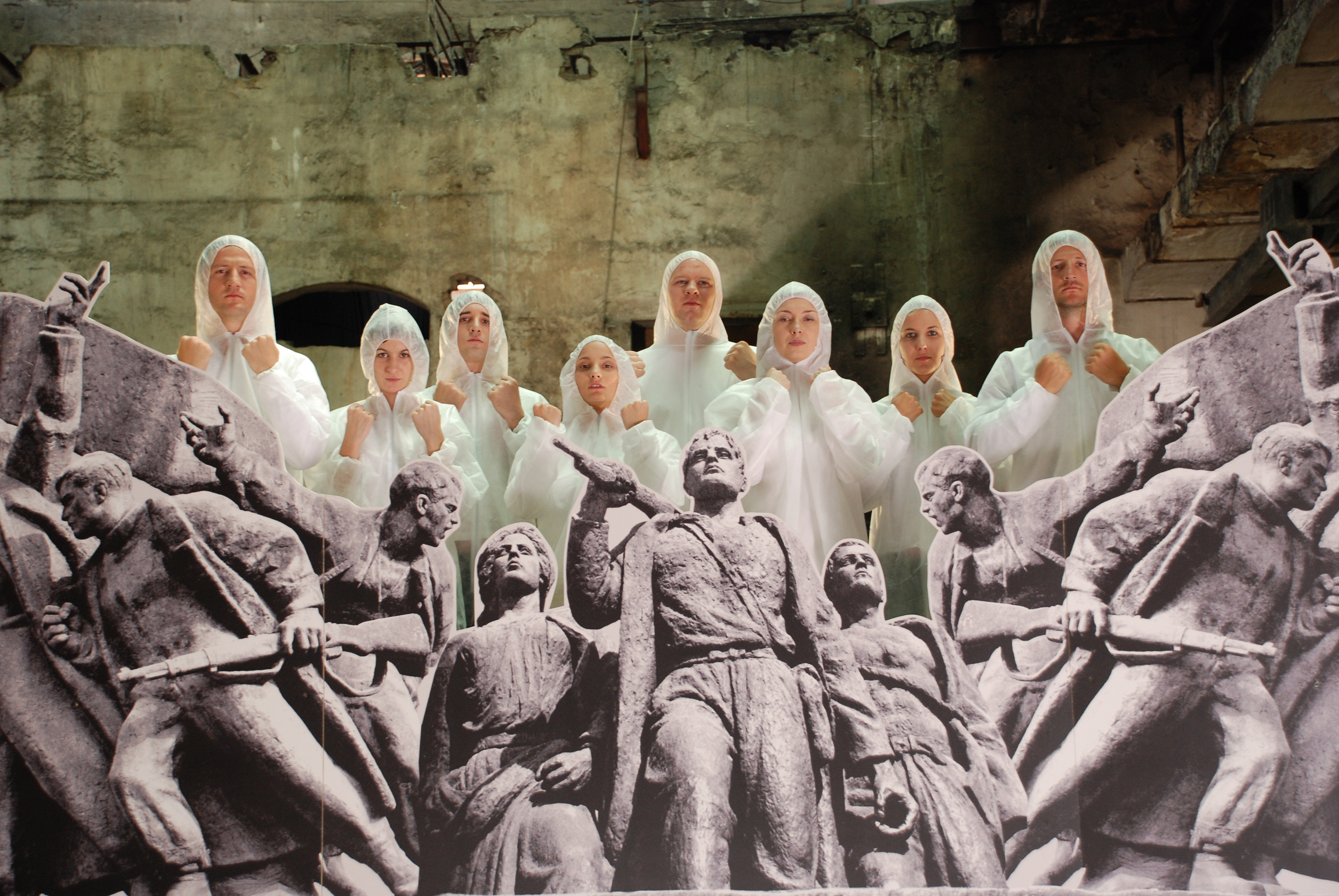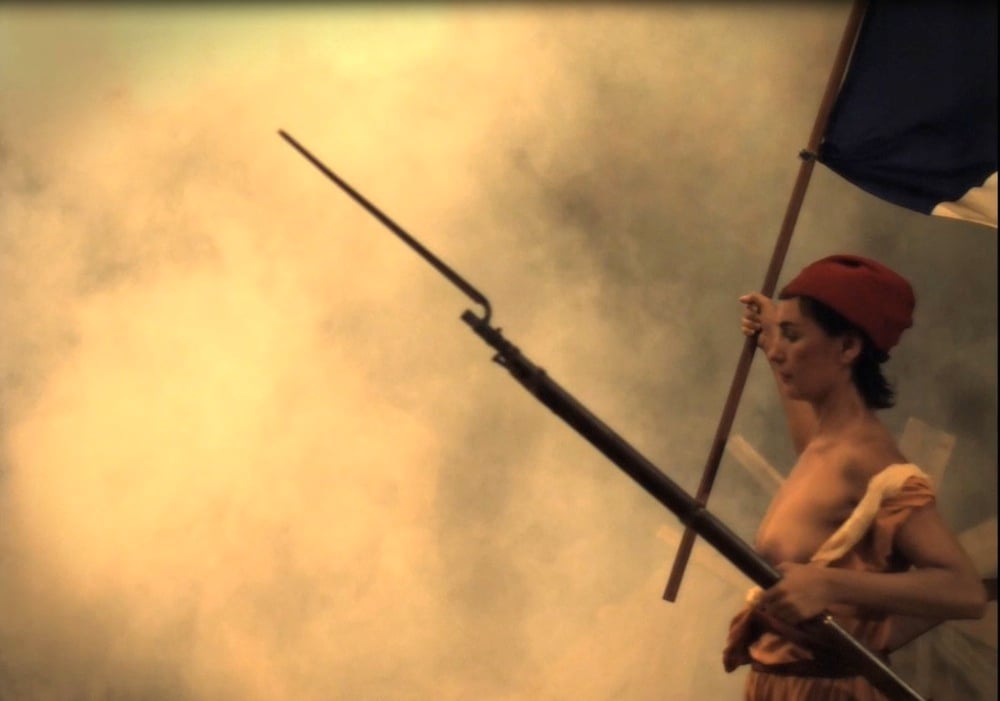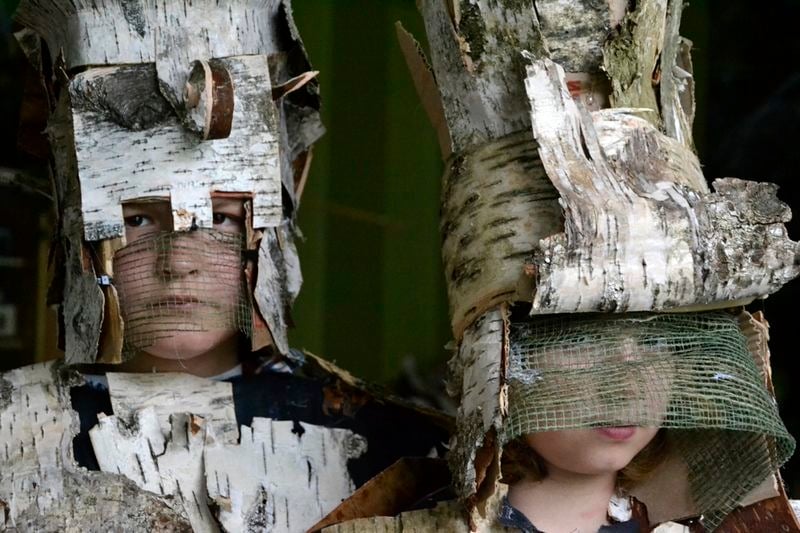What is to be done? Radical collective Chto Delat confront the paradoxes of political art

Multidisciplinary art collective Chto Delat are known for thoughtful, provocative reassessments of socialism's past, present and future that are not easily expressed in exhibitions. As their work goes on show at Calvert 22 Gallery in London, Agata Pyzik asks: why do they still do it?
In The Builders (2004-05), an early work by radical Russian art collective Chto Delat, five artists restage a painting in which rugged, socialist realist workers (four men and one woman) take a break from their labour (characteristically, the act of work itself couldn’t be represented in the idealised poetics of socialist realism) to pose hieratically against the distant backdrop of an industrial town. That town is Bratsk, in Siberia, and the painting is a Soviet classic, Viktor Popov’s Builders of Bratsk (1961). The Builders is typical of the preoccupations of Chto Delat, who often dust off the ancient traditions of the USSR in order to test their meaning in the here and now. Fifty years on from the original painting, the simple act of repetition reveals the new meaning of labour and community in the new post-communist reality. The new society is shown to be passive, incapable of change, hanging in the void — a commentary on the disappointment that followed the bold promises of the arrival of the democratic order in the early Nineties.
It was in response to the broken promises and missed opportunities of the Nineties that Chto Delat were formed in the early Noughties. Although it was founded by a core of artists Nikolai Oleinikov, Tsaplya, Dmitry Vilensky, Gluklya, and Kirill Shuvalov, it is now a loose, non-concentric group of artists, academics, and theorists that operates on many levels: they create art projects, write and publish neo-Marxist texts on politics and aesthetics, engage in political activism, make experimental film and theatre; until recently they also maintained an important blog, Chto Delat News. All their projects, however, are united by an interest in traditions of self-education and self-organisation, and by a self-conscious and ostentatious relationship with the past: their name (it means “What is to be done?”) is taken from the title of a radical novel by 19th-century author Nikolai Chernyshevsky.
Chto Delat’s reclamation of the old revolutionary art stands against the new cultural “trends” which have contributed to the construction of the new, corrupt regime and against kitschy new art that simply regurgitates western fashions. While others have claimed that censorship meant modern art struggled in Soviet Russia, they have stubbornly pointed to the politically engaged avant-garde of the post-revolutionary period in order to restate the simple truth that modern art was actually invented in Russia. They draw on a non-Stalinist communist past, as if carrying on the unfinished project of the avant-garde: they recall Constructivism and the Productivism of theorists like Alexei Gan and Boris Arvatov. At the same time, like their avant-garde forerunners, they also think internationally, not only referencing Bertolt Brecht and the Situationists, but also opening their activity outwards so that it can reflect their local situation. They exhibit often: most likely they are seen perceived by curators as contemporary Russia’s model “dissident” group. Yet they use their popularity to their advantage and stick to their local work — something that is very rare among artists in the former east.
“Chto delat draw on a non-Stalinist communist past, as if carrying on the unfinished project of the avant-garde”
Nevertheless, while their newspapers and essays are usually politically sharp and sophisticated, their exhibition activity is often disappointing: the biggest show to date in the UK, at the ICA in 2010, consisted of murals featuring classics of Marxism and infantilising slogans — “Work like a Stakhanovite!” and suchlike — which ultimately came too close to a sort of communist radical chic. Marx said we should “Let the dead bury their dead” — you can’t simply “repeat” a past revolution, yet in what they exhibit, if not what they write, Chto Delat seem to stick strictly to the October Revolution and to Paris 1968. Some might argue, therefore, that these narrow and nostalgic exhibitions actually undermine and trivialise the group’s important ideas.
The latest show to feature Chto Delat is Dear Art, curated by Croatian collective What, How & for Whom / WHW at Calvert 22 Gallery in London. (Calvert 22 Gallery is, like The Calvert Journal, a project of the Calvert 22 Foundation.) This show takes as its aim a deconstruction and questioning of the whole art world, posing questions about the validity — and corporate complicity — of contemporary art exhibitions. In a similar vein, then, we must ask: why do Chto Delat still exhibit?
In the first place, they are motivated by material necessity and political pragmatism. The group “doesn’t refuse a single proposition”, as group spokesman Dmitry Vilensky told Artur Żmijewski in recent book Post-Post-Soviet. The political problems and complete lack of institutional support in Russia makes Chto Delat dependent on the international scene and its grants. The group do not believe this compromises their credibility as oppositionists, at least according to Vilensky. It is predominantly an act of survival, a means of carrying on publishing the newspaper and producing new projects.
“From the late Eighties the former communist bloc was suddenly inundated with enormous amounts of Soviet kitsch”
It is, however, problematic, as the group consists not only of artists, but also of academics, some of whom teach philosophy at St Petersburg State University. In response, the group keep making works which dispute their participation in the art world, of which the best may be Museum Songspiel: The Netherlands 20XX, which is featured in the show at Calvert 22. The video piece takes place in an imaginary museum in the Netherlands in which a group of political refugees tries to claim asylum, only to be thwarted by the local extreme right. Finally, with no other solutions, the museum director proposes dressing them as Constructivist figures and making them pose as an avant-garde artwork. Their appropriation is complete when we hear pretentious gallery small talk from visitors who remark on the El Lissitzky in the museum collection.
Secondly, exhibiting is important because it facilitates communication. Despite the avant-garde’s attempts to remove the work from the petrifying influence of the white cube, exhibitions remain the most typical way of disseminating art. This perhaps explains why these exhibitions are often disappointing. Chto Delat are, of course, post-post-conceptual artists, whose activity isn’t even a critique of art’s premises. Instead, they use typical “revolutionary” avant-garde art forms to begin a discussion about aesthetics. This should be understood within the context of the post-Soviet experience: from the late Eighties the former communist bloc was suddenly inundated with enormous amounts of Soviet kitsch — realist, postmodern art, which would, in a very simplistic way, take advantage of our status as “poor victims of the regime”. Lots of incredibly bad post-Sots Art painting was done in that time, and many previously interesting Sots artists like Vitaly Komar and Alexander Melamid, and Alexander Kosolapov indulged in endless repetition of the same kitsch forms. Chto Delat didn’t want to participate in that. Although they do refer to the first politicised avant-garde of the Twenties — to Constructivism, Productivism or Futurism — in their hands it’s a way of discussing the validity of ideas, not forms. If their productions, like the so-called Songspiels, recall some of the agitprop engaged art of the Twenties, they do still retain the original ideas behind gestures like Brecht’s alienation effect and his tradition of epic theatre. Which is to say, they are fairly simplistic and didactic while but not without humour and irony.
“Many are operations on history that reveal the hidden meaning of historical events”
Like their predecessors in the avant-garde, Chto Delat make use of the power of dialectics. Chto Delat may be artists of the new type, who combine art with research work and political commitment, but when they make reference to realism or epic theatre, they are clearly seeking to make use of the transformative, dialectical qualities of art. This is the third reason for continuing to exhibit — the aura of art that allows special conditions, and an opportunity to change not only aesthetics, but also the reality entangled in it.
For instance, take the songspiel 2+2: Practicing Godard, which was inspired by Jean-Luc Godard’s film about the Rolling Stones One + One, which was taken away from the French director by its producer. Chto Delat transformed this incident into a commentary on the state’s control over images after Vilensky was asked to delete his film following a police raid on one of group’s seminars. It’s one of many references to a militant tradition in art, part of an attempt to expose social relations.
But it is this same dialectical quality that makes it hard to demonstrate the effects of the group’s intellectual research at an exhibition: their art is about an intellectual process. What is presented, therefore, are only random objects that are symptomatic of a new artistic practice that doesn’t produce works of art anymore, but rather, like the Constructivist avant-garde, produces material and intellectual experiments.
Nevertheless, the works they produce are valuable because they help to dehistoricise discourses. Many are operations on history that reveal the hidden meaning of historical events, like Partizan Songspiel, which revives the legend of Yugoslavian partisans, led by Marshal Tito, as part of a contemporary political battle over Yugoslavia’s socialist past. Chto Delat treats history like a living organism, not a fossil, in order to take on old conflicts that are still toxic in the present. A similar role is played by “re-enactments”, like Activist Club (2007) a temporary space that relived the experience both of Alexander Rodchenko’s Worker’s Club (1925) and of the widespread self-organising workers’ clubs of Soviet Russia. Another was Angry Sandwich People (2005), a picket staged on the Square of Strikes in St Petersburg — the site of the massacre of demonstrators that kickstarted the 1905 revolution — in which the slogans on the placards were all taken from Brecht’s poem In Praise of Dialectics.
Ultimately, for Chto Delat, I suggest, art is a necessary evil. While transforming the traditional role of an artist, the collective must still participate in the art circuit. The role they play within it (like in the big Ostalgia show in New York’s New Museum) may in itself help to expose the condition of the post-colonial, post-communist subject, one whose oppression can be commodified into an “artistic” effect for a wistful exhibitions featuring the cliches of post-communist nostalgia. Chto Delat’s work, in contrast, eschews images of the space programme, Chernobyl, ruined tower blocks, faded murals of heroic workers and so forth.
My investigation into to the question of why Chto Delat still exhibit raises only possible interpretations, ones which necessarily compartmentalise activity which actually transcends such divisions. In essence, Chto Delat are engaged in a new kind of artistic activity, which cannot be reduced to producing objects, or ideologies or, what is needed above all, political effect. What is undeniable, however, is that their activities have helped to provide a template for new types of political and artistic engagement. They have had a profound effect at least on the local artistic scene, contributing to the emergence of the new generations of artists and activists, like Voina or Viktoria Lomasko. Moreover, their work has anticipated the problems, and potential solutions, facing the new activist leftist groups that emerged during the 2011-2012 protests, who are eager to participate in social change and even become a motor of it. This new Left, like Chto Delat, refer to the socialist policies of the USSR, often positively, yet with an urge to correct their mistakes.



